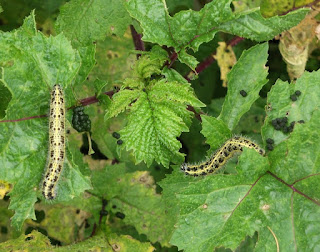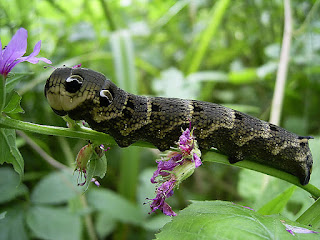 |
| Large White Pieris brassicae caterpillars in munching fest |
Well, it’s been a while... It feels very much as though some key components of my world have been conspiring against me to prevent life from ticking along in its usual manner, and as a consequence, I’ve been getting behind with a number of tasks, my blog being one of them.
So, where do I start? Lot's been happening, so there’s the very real danger that this entry could turn into a long and meandering voyage through the recent depths of my mind and hastily scribbled notes, and as such could be something of a long one. However, due to the cable on my new laptop power thingy being considerably shorter than I’m used to, I’m unable to position my laptop in such a way as to use the keyboard comfortably, and am already suffering the effects in my right hand especially. And, as I’m already living with a knackered left upper arm for similar reasons, perhaps my ramblings will be prematurely curtailed…
On the Narcolepsy front, as usual as I’ve had one or two good days, when I can almost pretend I’m vaguely ‘normal’, and as usual, there have been a good number of real stinky days, when even the smallest of things have been a battle, namely remaining sufficiently awake to function in a way even vaguely close to normality (upright would be a start!). I’ve also suffered at the hands of bureaucracy but will save you the details, only to say that this time the metaphorical gloves are on and I will not be going down without a fight.
To be honest, contrary to one of the purposes behind this blog, I’m not really in the mood to talk about Narcolepsy, as I’m finding it all rather tiresome at the moment (no pun intended), especially when later today, one of my tasks has given me no choice but to dissect its every impact on my life in such a way as the abovementioned bureaucrats can understand it. It also doesn’t help that due to unintentionally dozing off mid-Epley manoeuvre this morning, it looks like I’ll be blessed with a nagging headache and bleary brain for the remainder of the day, not to mention extra crackly and troublesome ears due to my interrupted exercises but that’s probably another story altogether. Hey, c’est la vie though, and at least the sun is shining today!
Now, where was I? Ah, nature.
 |
| Bright-Light Brown-Eye Lacanobia oleracea caterpillars |
Caterpillars, hmm? They’re everywhere - hanging out in my garden, hiking along the coastpath, marching down the road, dangling from branches in trees, munching through patches of overgrown vegetation in my wildlife garden-to-be, and also living in a well-furnished container atop the family DVD collection. The latter specimens were found clinging to a cultivated Primula sp. in our garden, and took some identification, not being a caterpillar I have any recollection of encountering previously. After much consultation of the caterpillar bible (Porter, 1997), the only likely candidate I could find was the Dog’s Tooth (Lacanobia suasa); however, this is considered scarce in Cornwall. So, off to the Cornwall Moth Group I went, and after eventually posting some photos (NB. I am once more with functioning camera), the considered opinion (thanks to Leon and Phil) is that my two new family members are larvae of the Bright-line Brown-eye (Lacanobia oleracea (Mamestra oleracea)), a caterpillar with similar markings to the Dog’s Tooth but much more common in Cornwall. It turns out that there are two morphs of L. oleracea, one being the brown form that is similar to L. suasa, and one being the green form that is depicted and referred to in Porter. Out of curiosity and a perhaps unhealthy parental attachment to my new ‘children’, we have decided to rear the caterpillars to adulthood, so watch this space…
Despite managing to forget my gardening gloves yesterday, it was with some excitement that I took myself off for a lone visit to the piece of land that I’m involved in converting to a wildlife garden. One of the reasons for my extra excitement was that at long lost I was in possession of a fully-functioning camera, and I was rapidly rekindling my love of simply wandering around seeking out all manner of things to photograph. And as it turned out, I was not to be disappointed.
 |
| Turnip Sawfly Athalia rosae caterpillar |
Due to a temporary period of neglect on the renovation front, the site is currently home to several impressive patches of Oilseed Rape (Brassica napus), and whilst there are many reasons why I have gripes with this particular species, I have to admit to, rather reluctantly, being forced to sit somewhere on the fence with regard to its environmental impact, due principally to the support it provides to a large variety of invertebrates and birds (e.g. Gruar et al. 2006; Stoate et al. 1998; Wilson et al. 1996). A not-so-close examination of the plants revealed that it to be home to a very respectable population of both Large White butterfly (Pieris brassicae) and Turnip Sawfly (Athalia rosae) caterpillars, all merrily munching their way through the previously-unwanted crop, plus a single unidentified pale geometrid species. In addition to the caterpillars, numerous spiders were sitting in webs spun across leaves and stems, a handful of earwigs scuttled this way and that, whilst above my head, a small murmuration of starlings sat on the telegraph wires, chattering away as I went about my business.
Still on the caterpillar front, a couple of weeks ago, whilst pottering in the garden, the Small Person (she of the new-found caterpillar-detecting skills) spotted a small but perfectly-formed Elephant Hawkmoth (Deilephila elpenor) caterpillar casually clinging to brush of a garden broom. Presumably due to its age/size, this specimen appeared much darker in colour than usual and lacked the mottled appearance of those I’d encountered in the past; however, its distinctive eye-spots and tell-tale cream-tipped hook were all present and correct. Promptly named as ‘Pretty Heart’, the lovely creature was taken to show my Other Half before being returned to the garden, where it was placed on fresh Hoary Willowherb (Epilobium parviflorum), upon which Pretty Heart, rather gratifyingly, immediately began heartily munching.
 |
| Elephant Hawkmoth Deilephila elpenor caterpillar Image credit: Lily M 2005 http://commons.wikimedia.org/wiki/File:Zmrocznik_g%C5%82adysz_Deilephila_elpenor.jpg |
Well, time is pressing on, so rather sadly, it looks like any further ramblings, observations and anecdotes will have to wait for another time…
References
Gruar, D., Barritt, D. & Peach, W.J.(2006) Summer utilization of Oilseed Rape by Reed Buntings Emberiza schoeniclus and other farmland birds: Capsule Oilseed Rape was the preferred breeding season habitat for Reed Buntings on arable farmland and reduced this species' dependence on wet features Bird Study 53(1): 47-54.
http://dx.doi.org/10.1080/00063650609461415
References
Gruar, D., Barritt, D. & Peach, W.J.(2006) Summer utilization of Oilseed Rape by Reed Buntings Emberiza schoeniclus and other farmland birds: Capsule Oilseed Rape was the preferred breeding season habitat for Reed Buntings on arable farmland and reduced this species' dependence on wet features Bird Study 53(1): 47-54.
http://dx.doi.org/10.1080/00063650609461415
Porter, J. (1997) The Colour Identification Guide to Caterpillars of the British Isles: Macrolepidoptera Viking Press, London.
Stoate, C., Moreby, S.J. & Szczur, J.(1998) Breeding ecology of farmland Yellowhammers Emberiza citrinella Bird Study 45(1): 109-121.
http://dx.doi.org/10.1080/00063659809461084
Wilson, J.D., Taylor, R. & Muirhead, L.B.(1996) Field use by farmland birds in winter: an analysis of field type preferences using resampling methods Bird Study 43(3): 320-332.
Stoate, C., Moreby, S.J. & Szczur, J.(1998) Breeding ecology of farmland Yellowhammers Emberiza citrinella Bird Study 45(1): 109-121.
http://dx.doi.org/10.1080/00063659809461084
Wilson, J.D., Taylor, R. & Muirhead, L.B.(1996) Field use by farmland birds in winter: an analysis of field type preferences using resampling methods Bird Study 43(3): 320-332.
No comments:
Post a Comment